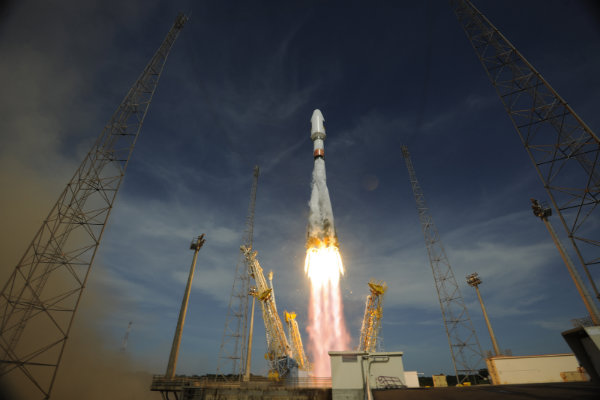The European Space Agency is on track to orbit four more of its Galileo navigation satellite by year-end, giving it eight in orbit to allow the provision of early services from early 2015.
ESA director general Jean-Jacques Dordain, speaking at his ILA press briefing, said everything looks good for the scheduled 21 August launch of two spacecraft. Those satellites are at Europe’s spaceport in Kourou, French Guiana, being readied for integration with their Soyuz rocket, and a third is now in vacuum testing at ESA’s ESTEC technical centre in the Netherlands.
Production was slowed last year by technical troubles encountered by OHB in Bremen, which builds the satellites around navigation payloads produced in the UK by Surrey Satellite Technology, but Dordain says he is confident in the production rate now being achieved.
Further units will be launched as rapidly as possible. For now ESA can launch two at once by Soyuz, but a special variant of its Ariane 5 launcher will soon be able to carry four.
With the four satellites now in orbit, a ground user can only receive a Galileo signals a few times a day. Eventually, 27 spacecraft plus will provide constant, global coverage.
Though the programme has been dogged by delays and cost overruns since its conception in the early 2000s, Europe’s is determined to have independent – and civilian-controlled - access to what it considers a critical technology for modern society.
That political stance has taken on some acute relevance now that satellite navigation has become a sore point in the developing sanctions battle between the USA and Russia over events in Ukraine. Earlier this month, Russia announced it would deny the US access to 11 GPS ground stations in Russia unless the USA changed tack and acceded to Russian requests to establish ground stations in the US for its GLONASS constellation.
However, said Dordain, Europe will have no such troubles with Galileo. The European Union, he said, has made it a “firm requirement” that ESA to put all necessary ground stations on European territory: “I think there are enough European territories around the globe.”
Meanwhile, Galileo is performing beyond expectations. The four satellites already flying – including two validation units orbited by ESA’s first Soyuz launch in 2011 and two more launched a year later (pictured) – are providing 2m (6.5ft) horizontal by 4m vertical accuracy. System specification had been for 4m by 8m precision.

Source: Flight Daily News























